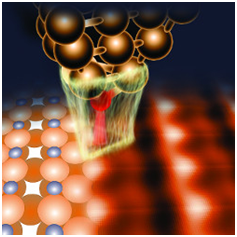STM/AFM THEORY APPLIED TO OXIDE NANOSTRUCTURES FOR CATALYSIS AND ENERGY APPLICATIONS
WG1 members: Ruben Perez, Milica Todorovic, Krzysztof Kosmider, Ruth M. Casado, Lucia Rodrigo, Diego R. Hermoso
homepage: www.uam.es

Theoretical simulations in combination with STM/AFM experiments provide insight into the atomistic mechanisms involved in the catalytic and optoelectronic activity of reducible oxide surfaces.
An atomic-scale understanding of the surface properties and chemistry of reducible oxides is essential to enhance their industrial applications. Scanning Tunneling (STM) and Atomic Force (AFM) microscopies are the tools of choice for this task. Our theoretical group has developed first-principles simulation techniques to study the electronic and transport properties of materials that allow us to simulate STM/AFM operation. We work in collaboration with experimental groups to understand the contrast formation mechanisms of AFM and STM imaging of reducible oxide surfaces.
We are currently involved in four different projects: (1) Force Spectroscopy, Tip identification and Kelvin Probe Force Microscopy on the rutile TiO2(110) surface; (2) Understanding the redox properties and catalytic activity of defective CeO2 surfaces; (3) Understanding simultaneous AFM & STM imaging of metal oxides using the Cu-O (100) and (110) oxide surfaces as models; and (4) surface characterization and defect identification on the clean and functionalised anatase TiO2 (101) surface.


